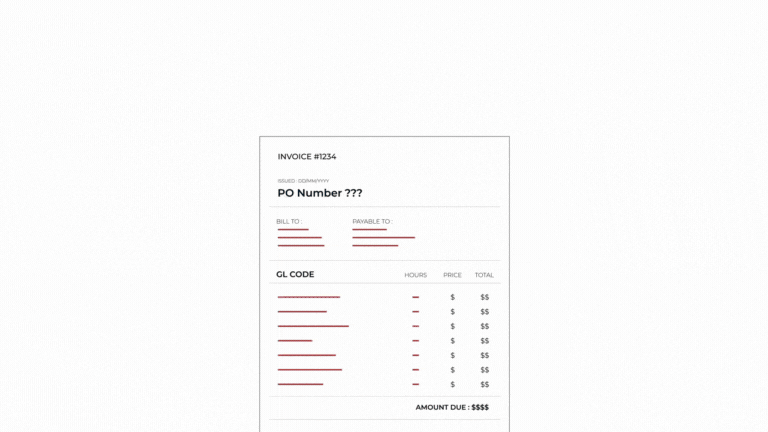
In today's business landscape, mid-sized companies face a delicate balancing act between growth ambitions and operational efficiency. Amidst this challenging environment, one aspect that can significantly impact your company's success is how you manage your accounts payable (AP) processes.
Traditional AP processes can be cumbersome, time-consuming, and error-prone, hindering your organization's ability to thrive which then places extreme pressure on your AP department. AP teams are expected to capture invoices quickly and accurately, meet payment deadlines consistently, and detect fraudulent activity. Meanwhile, they must balance supplier satisfaction and process changes from upper management that may slow down their workflow.
However, with AP automation, you can revolutionize your financial operations, relieve some of the pressure on your AP team, and make touchless invoicing a reality.
While AP automation has become integral for modern AP processes, many leaders at mid-sized companies may be unsure whether their company is ready to go all-in on AP automation. We’ll show you the five signs that your company is ready to eliminate manual AP processes and where to start in your AP automation journey.
AP Automation: Empowering AP Teams to Provide Deeper Value
In 2023, 71% of AP leaders believe “smarter” systems are the best way to impact AP performance and drive more efficiencies. Additionally, two-thirds of all business executives saw AP as “exceptionally valuable” or “very valuable.” By contrast, only a third found it this valuable six years ago.
However, some AP teams aren’t able to be as productive as they’d like to be. They are busy wading through stacks of paper invoices, manually keying and correcting invoice errors, and handling continuous supplier inquiries. And although AP teams have a huge impact on an organization’s transactions, liquidity, and supplier relationships, nearly one in four (22%) AP teams say they don’t even have a payment plan in place. With inefficient strategies that can’t keep pace with the rest of the organization, these AP teams miss out on significant opportunities to help improve their company’s financial performance.
According to a recent study by Ardent Partners, 50% of AP teams agree deeper and more agile analytics are key to achieving higher performance levels. AP departments have proved their value by using automation software to develop and produce actionable insights that the business can capitalize on. These insights include better monitoring of outstanding invoices, potential cash shortages, opportunities for cost savings, and gaining a deeper understanding of approval cycle times.
Five Signs You’re Ready for AP Automation
Here are five recognizable signs indicating your mid-sized company is ready to fully commit.
Volume Overload
If your mid-sized company deals with a substantial volume of invoices, manual invoice processing can become overwhelming and time-consuming. As a mid-sized company, this puts a strain on smaller AP teams that simply don’t have the resources to process large amounts of invoices through manual processes alone.
Real-world example: A mid-sized company typically receives a moderate number of invoices, such as around 200 per month. However, during a busy period or after a significant business expansion, the number of suppliers and purchase transactions drastically increases. Let's say the company experiences a surge in invoices and receives around 600 in a single month.
Handling this sudden spike in invoice volume becomes overwhelming for the AP team, especially if they rely on manual processing methods. The team may struggle to process such a large number of invoices within their regular time frame, leading to delays in approval and payment processing. This volume overload can cause backlogs, errors in data entry, and a lack of real-time visibility into the company's financial obligations.
The AP team may struggle to maintain efficiency and accuracy with manual processing alone, resulting in potential strain on supplier relationships and missed payment deadlines. Implementing AP automation can be an effective solution in such situations, as it enables the team to handle the increased invoice volume more efficiently and ensures timely processing and payment without the burden of manual intervention.
Frequent Invoice Errors and Discrepancies
If your AP team is constantly grappling with recurring invoice errors, such as data entry mistakes, payment discrepancies, or duplicate payments, it's a strong indicator that automation is worth the investment for your organization.
Real-world example: Suppose a mid-sized retail company receives a high volume of invoices from various suppliers on a daily basis. Despite the AP team's best efforts, they frequently encounter discrepancies in invoice amounts. Some invoices might include errors in pricing, quantity, or discounts, leading to incorrect totals.
These discrepancies could be due to data entry mistakes, miscommunication between the company and the supplier, or even errors in the supplier's billing system. As a result, the AP team must spend additional time investigating and rectifying these errors, which can cause delays in processing payments and create frustration for both the AP team and the suppliers.
The repeated occurrence of invoice errors and discrepancies can also strain the company's relationships with suppliers, potentially leading to payment disputes. To address this challenge and ensure accurate invoice processing, the AP team might consider implementing AP automation software, which can automatically validate invoice data, perform invoice matching, and reduce the likelihood of human errors.
Lengthy Approval Cycles
In 2022, 57% of AP teams said their top challenge was invoicing and payment approvals taking too long. Again in 2023, they indicated the same problem, with 47% of AP teams ranking it number one on their problems list. Furthermore, it takes an average of 10.9 days for an AP department to process a single invoice.
When invoice approval workflows encounter multiple stakeholders and frequent bottlenecks, it hampers the smooth processing of payments and causes tension with suppliers.
Real-world example: Let's say the company's invoices must go through three levels of approval before they can be processed for payment. The first level of approval involves the department head or project manager, who must verify the invoice’s accuracy and legitimacy. After this initial approval, the invoice is forwarded to the finance department for further scrutiny and compliance checks. Finally, the invoice goes to the senior management team for final approval before it can be processed for payment.
With a multi-layered approval process, the AP team often faces delays as invoices move through various hands and departments. Each level of approval may have its priorities and deadlines, creating obstacles in the approval workflow. Additionally, if approvers are unavailable or delayed in their responses, it further extends the approval cycle, impacting the overall payment processing time.
Consequently, suppliers may experience delayed payments, leading to frayed relationships and the potential loss of early payment discounts. The AP team may struggle to meet payment deadlines, and the lack of timely payments can impact the company’s image.
By implementing AP automation software, the company can streamline the approval process and expedite invoice processing. AP automation facilitates faster invoicing through various methods, such as:
- The creation of customized approval workflows, ensuring invoices are routed to the right approvers promptly.
- Reduction of invoice exceptions through automatic data correction and PO matching.
- Digital invoicing, which shortens the invoice delivery time to minutes.
This reduces approval delays, enhances transparency, and accelerates the overall AP cycle, improving efficiency for the AP team and suppliers alike.
Rising Fraud Concerns
Just last year, nearly four in ten businesses reported a business payment fraud attack. While not all attacks were successful, it’s clear that strategies and tools designed to prevent them are becoming increasingly important.
Real-world example: Let's consider a scenario where an external fraudster gains unauthorized access to the company's vendor database. The fraudster creates a fictitious vendor entry under the name "TechCom Solutions" and provides false contact information. They then submit fake invoices for services that were never rendered to the company.
Due to the lack of stringent vendor verification procedures, the ghost vendor "TechCom Solutions" gets approved for payment, and the company unknowingly disburses funds to the fraudster.
Implementing AP automation with invoice validation checks and vendor verification can be highly beneficial. Automation can help identify and flag suspicious invoices, which ensures the company only processes legitimate payments to authorized vendors and protects the company from potential financial losses.
Increasing Costs for Invoice Processing
The average cost to process a single invoice (including labor, overhead, and technology) is $10.18, up nearly 10% from the cost in 2022. Nevertheless, AP automation offers a solution to mitigate this burden. A best-in-class AP automation platform can reduce your invoice processing costs by 76%, according to the AP Metrics That Matter in 2023 report.
Real-world example: Suppose an AP team currently handles a large number of paper invoices manually. The company incurs expenses for the time and effort required for manual data entry and invoice approval. Moreover, the manual process might lead to errors and delays, potentially resulting in late payment fees and missed early payment discounts.
To achieve cost savings and improve efficiency, the company invests in AP automation software. By implementing automation, the company eliminates paper invoices and the need for manual data entry. Invoices are now received electronically, and the software automatically captures and validates the invoice data. This reduces paper-related expenses and significantly cuts down on the time required for invoice processing.
Additionally, AP automation software streamlines approval workflows, ensuring faster processing times and timely payments. The company can now take advantage of early payment discounts offered by suppliers, leading to cost savings on purchases.
As a result of implementing AP automation, the company achieves its desire for cost savings and efficiency. The AP team can allocate more time to strategic financial tasks and supplier relationship management, while the company benefits from optimized financial operations and improved cash flow management.
AP Automation: Taking the First Step in Your Journey
The first step in your AP automation journey is identifying your organization’s unique technical requirements and business goals. Take the time to explore the current pain points your AP team is experiencing that may be impacting the financial health of your organization. Once you compile your criteria and areas for improvement, you can begin your search for a right-fit AP solution partner.
AP automation is not a one-size-fits-all solution. So, recognizing your organization’s needs for this powerful technology, assessing the value your AP team can provide with the right tools, and selecting a provider who will tailor their solution to your company’s needs is pivotal for success.
Transcepta’s AP Automation solution helps AP teams improve supplier relationships by eliminating manual processes, speeding up invoice approval, and providing visibility into every part of the AP process. To learn more or to schedule a demo, contact us.



